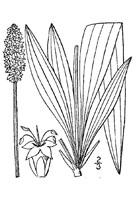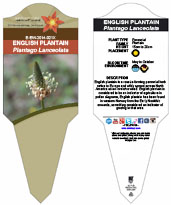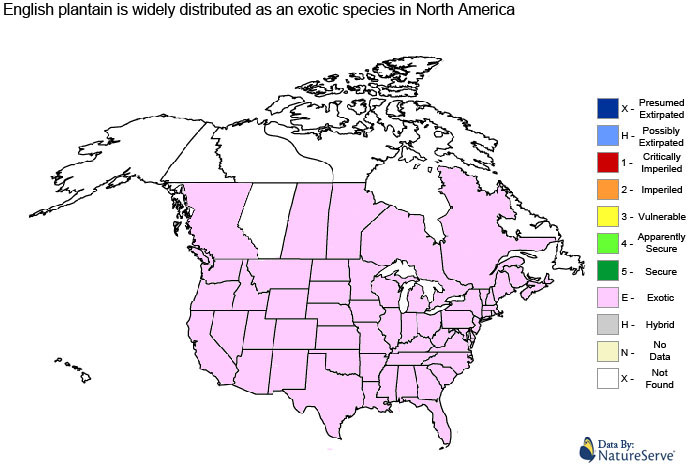English plantain is a rosette-forming perennial herb native to Europe and wildly spread across North America as an invasive weed. English plantain is considered to be an indicator of agriculture in pollen diagrams, English plantain has been found in western Norway from the Early Neolithic onwards, something considered an indicator of grazing in that area. English plantain contains phenylethanoids such as acteoside (verbascoside), cistanoside F, lavandulifolioside, plantamajoside and isoacteoside. It also contains the iridoid glycosides aucubin and catalpol. The name plantago comes from the latin word planta which means "footprint". the species name lanceolata means "lance-shaped" in reference to the shape of the leaves.
Seeds from English plantain are harvested for songbirds in commercial bird seed production. A good fibre can be obtained from the leaves which is said to be suitable for textiles. A mucilage from the seed coats is used as a fabric stiffener. This mucilage is obtained by macerating the seed in hot water. Gold and brown dyes are obtained from the whole plant.

Within the realm of rational and holistic medicine, English plantain has been used frequently in herbal teas and other herbal remedies. A tea from the leaves is used as a highly effective cough medicine. In the traditional Austrian medicine Plantago lanceolata leaves have been used internally (as syrup or tea) or externally (fresh leaves) for treatment of disorders of the respiratory tract, skin, insect bites, and infections. English plantain is a safe and effective treatment for bleeding, it quickly staunches blood flow and encourages the repair of damaged tissue. The leaves contain mucilage, tannin and silic acid. An extract of from the leaves of English plantain has antibacterial properties. Internally, they are used in the treatment of a wide range of complaints including diarrhea, gastritis, peptic ulcers, irritable bowel syndrome, hemorrhage, hemorrhoids, cystitis, bronchitis, catarrh, sinusitis, asthma and hay fever.
Please note that MIROFOSS does not suggest in any way that plants should be used in place of proper medical and psychological care. This information is provided here as a reference only.
The young leaves of English plantain are edible raw or cooked. They are rather bitter and very tedious to prepare, the fibrous strands are best removed prior to eating. The very young leaves are somewhat better and are less fibrous. Seed, when cooked. can be used like sago. The seeds can be ground into a powder and added to flours when making breads or cakes.
English plantain is a rosette-forming perennial herb, with leafless, silky, hairy flower stems 15cm to 50cm tall. The basal leaves are lanceolate spreading or erect, scarcely toothed with 3-5 strong parallel veins narrowed to short petiole. Grouping leaf stalk deeply furrowed, ending in an ovoid inflorescence of many small flowers each with a pointed bract. Each flower can produce up to two seeds. Flowers are 3mm to 4mm in size with four bent back lobes with brown midribs and long white stamens. The flowers are hermaphrodite (have both male and female organs) and are pollinated by Wind, flies, beetles and is self-fertile. English plantain is noted for attracting wildlife.
| Plant Height |
15cm to 20cm |
| Habitat |
Fields, Waste places, Lawns |
| Leaves |
Lanceolate |
|
| Leaf Margin |
Entire |
|
| Leaf Venation |
Longitudinal |
|
| Stems |
Hairy Stems |
|
| Flowering Season |
May to October |
|
| Flower Type |
Elongated clusters of spirally arranged flowers on a leafless stock |
| Flower Colour |
White |
| Pollination |
Bees, Insects, Wind |
| Flower Gender |
lowers are hermaphrodite and the plants are self-fertile |
| Fruit |
Hard oval seeds |
| USDA Zone |
5A (-26°C to -28°C) cold weather limit |
No known health risks have been associated with English plantain. However ingestion of naturally occurring plants without proper identification is not recommended.
 |
-Click here- or on the thumbnail image to see an artist rendering, from The United States Department of Agriculture, of English plantain. (This image will open in a new browser tab) |
 |
-Click here- or on the thumbnail image to see a magnified view, from The United States Department of Agriculture, of the seeds created by English plantain for propagation. (This image will open in a new browser tab) |
English plantain can be referenced in certain current and historical texts under the following six names:
English plantain can be translated into the following select languages:
| Arabic |
اللغة الإنجليزية لسان الحمل |
Bulgarian |
живовляк |
Chinese (Sim) |
英语蕉 |
| Croatian |
Engleski trputac |
Czech |
angličtina Jitrocel |
Danish |
|
| Dutch |
Engels Weegbree |
Esperanto |
banano |
Estonian |
|
| Finnish |
Englanti piharatamo |
French |
|
German |
|
| Greek |
αρνόγλωσσο |
Hebrew |
לחך אנגלית |
Hungarian |
angol útifű |
| Italian |
inglese Piantaggine |
Japanese |
英語オオバコ |
Korean |
영어 질경이 |
| Low Saxon |
|
Lithuanian |
Anglų Gyslotis |
Norwegian |
|
| Persian |
انگلیسی درخت چنار |
Polish |
angielski babki |
Portuguese |
|
| Romanian |
engleză patlagina |
Russian |
английский Подорожник |
Slovak |
angličtina Skorocel |
| Spanish |
Inglés Plátano |
Swedish |
engelska groblad |
Tagalog |
|
| Turkish |
İngilizce otu |
Ukrainian |
англійська Подорожник |
Vietnamese |
chuối |
| The information provided in this conservation assessment has been provided by the Natureserve Database in conjunction with various federal, provincial, state, county, district, regional, and municipal governments as well as public and private conservation authorities. Information in this section is accurate from the last time this article was updated. |
 |
English plantain has no conservation status as it is considered an exotic and or invasive species in North America. |
 |
The MIROFOSS database offers free printable garden tags for personal and non-profit use. These tags can be used to properly identify plant samples in a garden. Click on the tags shown on the the screen or -click here- to download a full size jpeg image for an English plantain identification tag; which can be printed on paper or used with a plastic laser printer. |
 |
What's this?
This is a QR code (short for Quick Response) which gives fast-track access to MIROFOSS articles. QR Codes are barcodes that can be read by smart phone cameras. This QR Code is unique to this MIROFOSS article.
What can I do with it?
You can copy and print the QR code to a plant label, poster, book, web site, magazines, or newspaper so smart phone users can scan the QR Code which automatically takes them to this specific article. |

| Description |
Dickinson, T.; Metsger, D.; Bull, J.; & Dickinson, R. (2004) ROM Field Guide to Wildflowers of Ontario. Toronto:Royal Ontario Museum, |
| Application |
Hjelle, K. L.; Hufthammer, A. K.; Bergsvik, K. A. (2006). "Hesitant hunters: a review of the introduction of agriculture in western Norway". Environmental Archaeology 11 (2): 147–170. |
| Folklore |
Vogl S, Picker P, Mihaly-Bison J et al. (October 2013). "Ethnopharmacological in vitro studies on Austria's folk medicine--an unexplored lore in vitro anti-inflammatory activities of 71 Austrian traditional herbal drugs". Journal of Ethnopharmacology 149 (3): 750–71. |
| Image Rendering |
USDA-NRCS PLANTS Database / USDA NRCS. Wetland flora: Field office illustrated guide to plant species. USDA Natural Resources Conservation Service. |
| Environment |
National Audubon Society. Field Guide To Wildflowers (Eastern Region): Alfred A. Knopf. ISBN 0-375-40232-2 |
| Physical Identification |
National Audubon Society. Field Guide To Wildflowers (Eastern Region): Alfred A. Knopf. ISBN 0-375-40232-2 |
| June 13, 2015 |
The last time this page was updated |
| ©2021 MIROFOSS™ Foundation |
 |
|
|



















